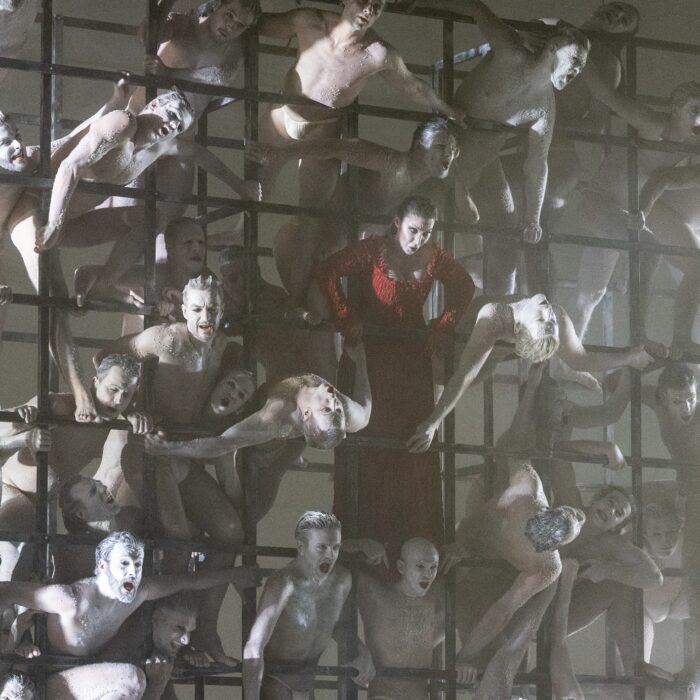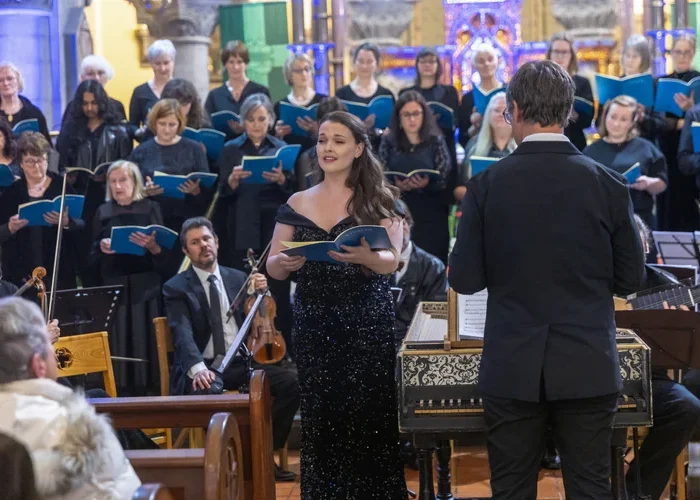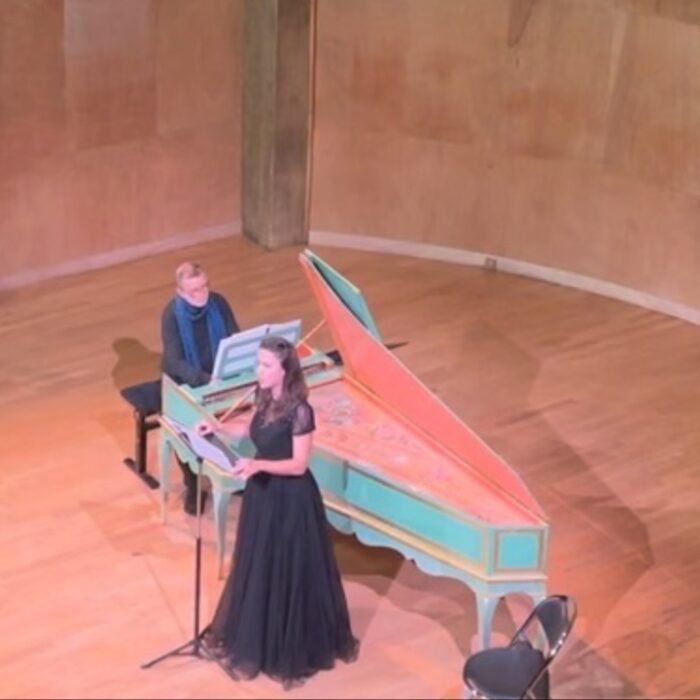
Maggio Musicale Fiorentino 2021-22 Review: Acis et Galatée
Lully Opera Finally Receives Belated Premier In The City Of His Birth
By Alan NeilsonPhoto: Michele Monasta
Born in Florence in 1632, Gianbattista Lulli left his native city at the age of 14 in the service of Roger de Lorraine for a life in France. He went on to become a master composer of French baroque music, and along with his librettist Philippe Quinault went on to establish a distinctly French form of opera, with their creation of the tragédie en musique, which itself gave rise to a tradition which was to take French opera in a different direction. In 1661 Lulli became a French citizen and changed his name to Jean-Baptiste Lully, the name by which he is recognized today.
However, anyone walking around Florence today in search of associations that tie the composer with his place of birth are likely to be disappointed, and with so many famous sons, such as Dante, Michealangelo, Machiavelli and the Medici family, it is hardly surprising that Florence may have overlooked someone who sought fame and fortune elsewhere. However, that is now beginning to change. Just recently, its mayor announced a project which aims to recognize Lully’s achievements, with the creation of the Gianbattista Lulli Institute in the Sala dei Gigli, in the Palazzo Vecchio, which is due to open this September. In November this year there will be an event, centered around a concert of Lully’s music, to celebrate the 390th year of his birth.
So it may not be a complete coincidence that the Maggio Musicale Fiorentino have just presented the Italian premier of Lully’s opera “Acis et Galatée,” a mere 336 years after its premier at Château d’Anet in 1686. Rather than a tragédie en musique, Lully called this opera a pastorale-héroïque, owing to its pastoral setting and the fact that it dispensed with the classical five act structure, in favor of a libretto consisting of a prologue with three acts, written by Jean Galbert de Campistron. As it turned out, this was to be the last work Lully wrote for the stage, as he died less than a year later.
For this belated premier, it was also notable that the program pointedly referred to the composer as Gianbattista Lulli, a clear sign of recognition that he was a Florentine by birth.
The opera is a representation of the Acis and Galatea myth as related in Ovid’s “Metamorphoses” in which the shepherd Acis is killed by the jealous cyclops Polyphemus, but is then restored to life by Neptune, and transformed into a river so that so that he can be forever with his lover, the sea nymph Galatea. It is a simple story, set in a world of gods, semi-gods and humans and other fabulous creatures, for which Lully provided elevated airs and ensembles separated by expressive recitative and instrumental movements, with each act containing a divertissement of choruses and dance.
A Pleasing Mix of Color and Movement
The staging was under the direction of Benjamin Lazar, with Adelin Caron as the scenographer, Alain Blanchot as costume designer and Christophe Naillet as the lighting designer, with Gudrun Skamletz responsible for the choreography. Together they served up an engrossing staging with plenty of color, marvelous costumes and eye-catching sets, and if it all looked a bit randomly put together, it was certainly none the worse for the fact.
Lazar sets the prologue in what appeared to be a modern day outdoor setting, with the cast fooling around, mocking the idea of the opera being dedicated to a king, while preparing to perform it. There was a basic wooden structure at the back, which was to act as a stage, situated among trees and other paraphernalia. Paintings were occasionally unfurled to act as small backdrops in front of which the singers performed, which gave it a deliberately amateur feel. The cast seem to have made use of whatever costumes had been at hand at the time, so that although they were well suited to their characters, they were from a range of disparate periods, yet all cleverly suggestive of antiquity, but definitely not of that era.
There was no defining aesthetic as such, apart from a general sense of the pastoral. In fact, it all looked like a colorful mess, but it worked exceptionally well. The sets were easy to transform, provided plenty of space, even for the elaborate dance routines, and were pleasing on the eye.
Skamletz’s choreography was in harmony with the music. It was graceful, at times playful, free flowing and elegant, conjuring up idyllic impressions of antiquity, again without any direct references to that period.
Sardelli Marks Time Using An Old Tradition
The musical side of the production was under the staff, yes the staff, of Federico Maria Sardelli, who decided to beat time, at least for parts of the performance, with a staff similar to that Lully would have used back in the 17th century, which incidentally was responsible for the composer’s death when he stabbed himself in the foot with one.
It made for an interesting listening experience, although not necessarily a pleasing one, as the pounding on the podium floor became increasingly intrusive. Fortunately, Sardelli used the staff only sparingly, and more importantly, managed to survive the evening with both feet in tact.
For the first time in its history the Orchestra del Maggio Musicale made use of period instruments, from whom Sardelli elicited a beautiful sound, expertly uncovering the score’s textural and rhythmic contrasts, without ever descending into excess.
His reading was lively, but always graceful and refined. The balance between orchestra, singers and chorus, which was positioned at the back of the pit in order to free up space on stage for the dancers and sets, was pleasingly managed.
Excellent Performances From the Three Main Protagonists
Acis was parted by the French haute-contre Jean-François Lombard whose light tenor proved ideal for the grief stricken hero. His voice has an innate delicacy which he used to craft exquisitely detailed lines, with subtly colored and well-placed dynamic inflections, always rendered without excess, which successfully carried his changing emotions. His attention to the nuances of the text was superb, every phrase was carefully and elegantly moulded to fit their meaning. It was also a very confident performance, one founded on a secure technique.
Galatée was played by soprano Elena Harsányi, whose performance was equally secure. She possesses a well-supported voice with an homogenous tone, which she used skillfully to define her character, convincingly bridging the gap between the human and the semi-divine. Although not a powerful voice, she projects it well so that she can easily hold her own with the orchestra and other singers. Her phrasing is crafted expertly, so that her airs and recitatives were delivered with a high degree of expressivity. Her confrontation with Polipème, at the end of Act one, was one of the high points of the opera, in which the sharp contrast in their voices not only highlighted the qualities of both voices, but also provided the necessary difference to energize the exchange.
Bass Luigi De Donato made a strong impression in the role of Polipème, managing to dominate the stage in more ways than one. Tall and with a large physique, he was provided with raised foot ware which meant he stood head and shoulders above the rest of the cast, while his costume, consisting of a striking mask and stunning black and red clothing, ensured that he was, indeed, a fearsome sight. He projected his dark, deep, full-bodied voice strongly and with a terrifying affect in what was a passionate, yet emotionally sensitive performance.
His love for Galatée was sincerely portrayed, both through his beautifully detailed and expressive singing, and in his clumsy nervous approaches as he attempted to woo her, turning him from an ogre into a sympathetic character, but one who is unable to control his frustrations.
Strong Supporting Cast
The supporting singers had plenty to do, as most were cast in multiple roles.
Tenor Sebastien Monti was parted as the long suffering Télème, for which he provided an emotionally ardent vocal portrait. His voice has a pleasing tone with a fair degree of flexibility, which he successfully employed to provide different vocal characterizations for his other two roles Le Arête de Junon and Apollon. Although the latter did expose certain weaknesses in the upper register.
Soprano Valeria la Grotta possesses a bright, at times piercing voice, which she uses in a very direct manner, and therefore, perfectly suited for her role as the hard-hearted Scylla, whom she portrayed as forceful, single-minded and cold. She also executed the roles of the goddess Diana and the small role of Deuxieme Naïde with equal success.
Soprano Francesca Lombardi Mazzulli gave a confident and convincing performance in the roles of L’Abondance, Aminte and the Premiere Naïde, which gave her ample opportunity to show off her enticing vocal timbre, versatility and ability to develop character. Her costume for L’Abondance amusingly displayed exuberant excess.
Baritone Guido Loconsuolo possesses a beautifully layered voice, with which he can conjure up dark colorful variations, and articulates with a pleasing clarity, which he used to produce an authoritative and expressively strong performance in the role of the sea god Nettuno.
Tenor Markus Van Arsdale put in a lyrically pleasing performance in the relatively small roles of Comus and Tircis.
The cast was completed by the soprano Silvia Spessot and bass Davide Piva in the small roles of a Dryade and Sylvain. Both made the most of their limited opportunities.
Performances of French baroque operas are rare events in Italy, so this performance of Lully’s final stage work was most welcome, and proved to be very successful, with the audience showing its approval with a long sustained period of applause. From a purely sentimental point of view, is was also interesting to see the Florentine public welcome back one of their own sons. Hopefully, there will be further stagings of his operas in the very near future.



